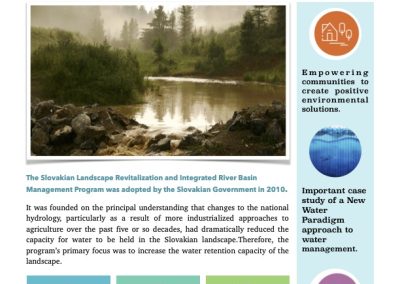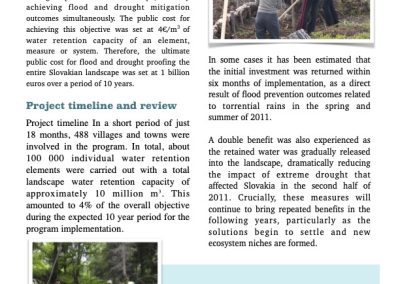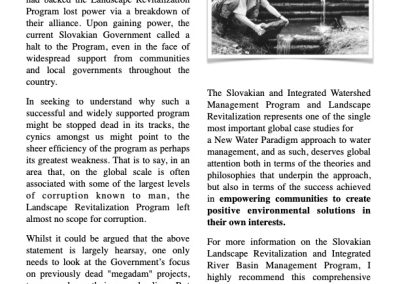
The Slovak Landscape Revitalization and Integrated River Basin Management Program was adopted by the Slovak Government in 2010
Program’s primary focus was to increase the water retention capacity of the landscape to prevent droughts and mitigate floods. It was founded on the principal understanding that changes to the national hydrology, particularly as a result of more industrialized approaches to agriculture over the past five or so decades, had dramatically reduced the capacity for water to be held in the Slovak landscape.
Project goal
To achieve the objective, the Program set a goal of restoring landscape water retention capacity of at least 250 million m3, focusing on damaged parts of the landscape, thereby achieving flood and drought mitigation outcomes simultaneously. The public cost for achieving this objective was set at 4€/m3 of water retention capacity of an element, measure, or system. Therefore, the ultimate public cost for flood and drought proofing the entire Slovakian landscape was set at 1 billion euros over a period of 10 years.
Project timeline and review
Project timeline In a short period of just 18 months, 488 villages and towns were involved in the Program. In total, the mayors of 488 municipalities carried out about 100 000 individual water retention elements with a total landscape water retention capacity of approximately 10 million m3. This amounted to 4% of the overall objective during the expected 10-year period for the program implementation.
In some cases, it has been estimated that the initial investment was returned within six months of implementation as a direct result of flood prevention outcomes related to torrential rains in the spring and summer of 2011.
A double benefit was also experienced as the retained water was gradually released into the landscape, dramatically reducing Slovakia’s extreme drought in the second half of 2011. Crucially, these measures will continue to bring repeated benefits in the following years, particularly as the solutions begin to settle and new ecosystem niches are formed.
Flood and Drought Prevention
Beyond the direct impacts on the local communities where these projects were implemented, the focus on municipalities in the upper watercourse sections has positively affected an estimated 500 to 1 000 communities in the lower river basins. Why? Because the measures have a beneficial influence on the reduction of flood and drought risks throughout the entire catchment.
Social and Economic Impact
Perhaps one of the most compelling aspects of the implementation of the Program related to its almost entire focus on local community skills and resources. During its short 18-month lifespan, the Program provided a total of 7,700 seasonal jobs for local people. In most cases, it utilized local natural materials such as soil, stone, and wood. The positive impacts of this approach were twofold.
Although only a small portion of the planned scope of the Program was implemented, this Slovakian case study demonstrates a globally significant example of a fundamental solution in combating climate change, ecosystem degradation, flooding, and drought risks. Firstly, the public funds invested provided positive local community outcomes far beyond the revitalization measures’ direct impacts. Secondly, by engaging the local community in designing and building the solutions themselves, the community took on board ownership and stewardship of the solutions. This was made abundantly clear in the remarks and obvious pride shown by numerous community members I met during my participation with The Flow Partnership on a tour of the Slovakian countryside with the Program’s director, Michal Kravčík. What was clear from our tour of these projects was just how popular they have been within the local communities. While traveling the Slovakian countryside with Michal, he was often stopped as he walked down the street, often by people whom he had never met personally, people who simply wanted to thank him for his work in their communities.
Lessons to be learned
But the response of the Government has been a different story. Unfortunately, after only two years in power, the Government that had backed the Landscape Revitalization Program lost power via a breakdown of their alliance. Upon gaining control, the current Slovakian Government called a halt to the Program, even in the face of widespread support from communities and local governments throughout the country.
In seeking to understand why such a successful and widely supported Program might be stopped dead in its tracks, the cynics amongst us might point to the sheer efficiency of the Program as perhaps its greatest weakness. That is to say, in an area that, on the global scale, is often associated with some of the most extensive levels of corruption known to man, the Landscape Revitalization Program left almost no scope for corruption. While it could be argued that the above statement is primarily hearsay, one only needs to look at the Government’s focus on previously dead “mega-dam” projects to see where their agenda lies. But regardless, one thing is absolutely without a doubt my mind:
The Slovakian and Integrated Watershed Management Program and Landscape Revitalization represent one of the single most important global case studies for a New Water Paradigm approach to water management. As such, it deserves global attention both in terms of the theories and philosophies that underpin the process and the success achieved in empowering communities to create positive environmental solutions in their own interests.
About the Author
Richard Widows is an agricultural scientist with ten years professional experience in the agricultural sector, with a particular focus in agricultural policy. He has recently completed a Masters in Holistic Science at Schumacher College in the UK. He works with the UK based Water NGO, the Flow Partnership.
Richard Widows visited several restoration sites in 2015 with Minni Jain and Phillip Franses.
About the Publication
The Valley Green Journal 2015 Special Book Edition featured this and other outstanding articles, published by the recently departed water ambassador Jan Lambert and Carmen Bywater, with contribution of authors around the world. ISBN: 978-0-9968633-0-8
For more information, please visit: https://bio4climate.org/2019/05/24/water-land-and-climate-the-critical-connection-how-we-can-rehydrate-landscapes-locally-to-renew-climates-globally-edited-by-jan-lambert-with-contributors-from-around-the-world/
Slovak Integrated Landscape and Watershed Restoration 2010-2012
by Richard Widows
This article was originaly published in 2015 by Jan Lambert in the Valley Green Journal Special Book Edition
Structures
Take away facts: during short time of 18 months, 488 townshipsconstructed 100 000 water retaining measures and projects, including cross check dams, A.S.A. beaver analogs and more…
M3 of Water
Since 2012, each year 10 milion M3 of retained rainwater repeatedly soaks in the ground, sustaining the ecosystems and recharging the aquifers. That´s 100 milions M3.
Jobs
Program created 7 700 seasonal jobs for local people, and ultilized localy sourced materials and resources. Resilient communities sustain resilient landscapes.
Townships
488 townships, villages and municipalities participated in the program in a short period of 18 months during 2011-2012 period. Total cost amonited to XX mil. euros (4€/M3)





